.22 caliber bullet velocity determination
with a simple rotating drum streak camera
Andrew Davidhazy Imaging and Photographic Technology School of Photographic Arts and Sciences/RIT The velocity of ballistic rounds is a matter of interest to many individuals, from hunters to ammunition designers and manufacturers. There are many instruments available to determine the performance of ammunition in terms of their velocity but none probably as simple as a basic streak camera. Velocity is something that is determined by measuring the elapsed time between the arrival of the round at one location in space and its arrival at a second location with the distance between these two locations accurately known. For slow moving objects this can be accomplished by using a chronometer and visually estimating the time of arrival of a subject at the two known locations. While this method works for slow subjects once they pick up speed it becomes a more and more difficult exercise. The rate at which bullets fly is impossible to determine by manual methods and something more sophisticated needs to be devised. This could be, and often is, some kid of an electronic "gate" and timer combination. The bullet flies over to photosensors and the time between interrupting the view of each sensors can be electronically accurately recorded and almost immediately the velocity of the round can be read out from the instrument's display. One may, however, accomplish a similar task by employing a "streak" camera. In such a camera the film is moved past an open slot at some known rate. This rate gives the camera a known "time base". This means that a certain length of film represents a certain amount of time. The film can be moved past the slot in a number of ways but a very convenient way to do it is to wrap it around the outside surface of a drum. By rotating the drum at a particular rate the velocity of the film may be accurately set and known. A basic rotating, "home made", drum type streak camera is shown in the photograph below. 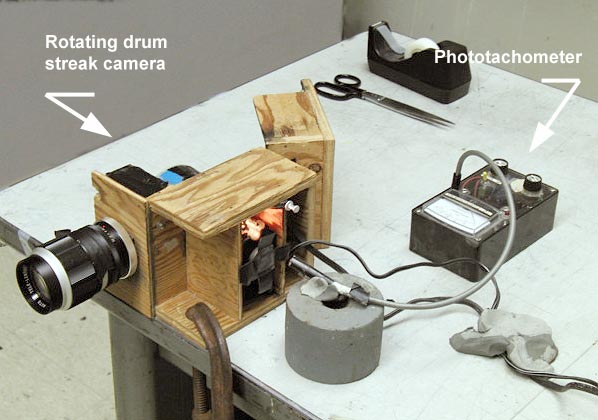 The drum is attached to a sewing machine or vacuum cleaner motor since these can achieve respectably high RPMs and are voltage sensitive. More volts produce higher RPM and thus better "time resolution" of the resulting record. The RPM of the drum are, in this case, monitored by a photo tachometer. 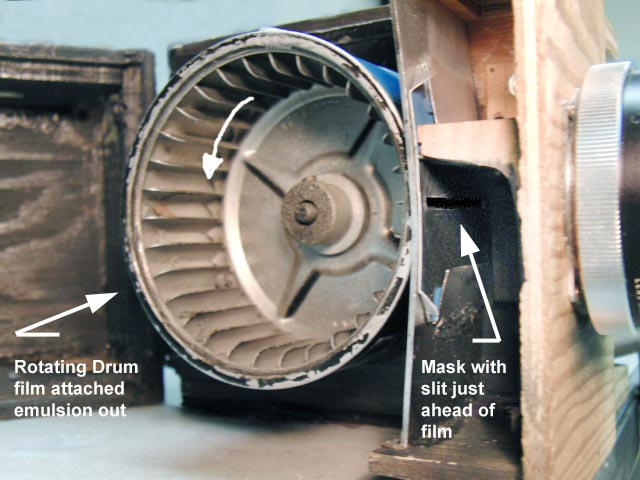 In the illustration above, you can see the squirrel cage drum that has been attached to the motor shaft and the slot located just in front of the film that is attached to the drum emulsion side out and fastened with simple transparent tape such as Scotch tape. The voltage to the motor is increased until the drum is turning at the desired rate. In this case, it was decided that the time-base of the record should be 1 inch per 1/1000 second. Since this drum has a circumference of 12 inches, the drum needed to move 12 inches of film past the slot at a rate of 1000 inches per second. This resulted in the drum having to rotate at the rate of 1000 inches per second / 12 inches per turn or 88.33 RPS or 5000 RPM. This was a bit beyond the nominal bursting strength of the drum but since it would be turning inside a confined space t was considered safe enough and so far there have never been any accidents resulting from the drum breaking. The camera lens is aimed at the location where the bullet will be flying. It will be passing as close as possible to two wires suspended just beyond the flight path of the bullet and located exactly 1 foot apart. The flight path of the bullet is made to fall on the slot of the camera. This is accomplished by first firing the gun across two pieces of paper attached to the marker wires. This leaves a hole in each piece of paper. These holes are traversed with a length of white string and the camera is adjusted in such a manner that the image of the string an the marker wires can be clearly seen falling within the edges of the slot in the camera. The marker wires will be perpendicular to the slot while the flight path indicator string image will be parallel and within the edges of the slot. The white string simply allows us to visualize and focus the lens on the flight path. Since the bullet moves so rapidly it is necessary to illuminate its flight path with copious amounts of light. The amount of light necessary to record a useful trace of its passage can be determined by knowing how long the bullet remains in a particular spot in space. This can be determined based on its length and its assumed velocity. In our case the bullet was about 10mm in length and assumed to be traveling about 300,000 mm per second. This means that as the bullet flies the bullet's surface reflects light back to the camera lens for 10 mm / 300.000 mm per second or about 1/30,000 second. A short time indeed. To secure a useable record a studio electronic flash with an output of abut 400 w/s was placed about 12 inches away from the flight path. 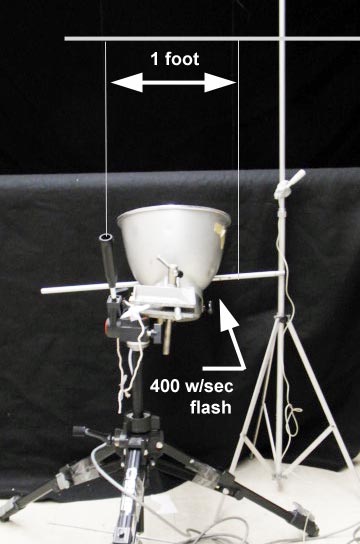 Studio flashes have an inherently long duration because they provide lots of light but to accomplish this they typically compromise on short duration. The duration of most of these flashes it turns out is long enough so that the bullet is lit fairly well over a flight path of maybe 2 feet or so. That is about 1/500 second if the bullet travels at 1000 feet per second. The flash was triggered by a sound synchronizer set-up about a foot ahead of the first marker string so that by the time the bullet arrived at the first marker the flash would be already putting out almost its maximum output. Although the output is non-linear it is sufficient to illuminate the flying bullet as it crosses from one marker wire to the next and a little more. The background needs to have close attention paid to it because while the bullet require a lot of light since it is in a particular location for a very short time, the background remains in the same place all the time the flash discharges it light. If precautions were not taken the background would be significantly overexposed hiding in "noise" the 'signal" associated with the flying bullet. To minimize exposure to the background it is made to a as dark and light absorbent as possible This is accomplished by "masking" the light in such a manner that the light from the flash is prevented from falling on the black background directly behind the flight path of the bullet. All this is arranged as shown in the accompanying photograph. 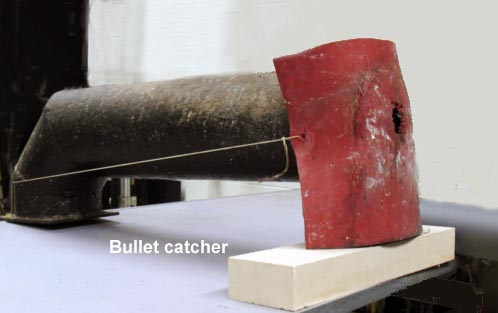 Needless to say the bullet needs to be stopped once it has accomplished its mission and for this we use a bullet catcher made of heavy iron and filled partially with sand. This particular bullet catcher has stopped bullets considerably larger than the .22 ones we use for this experiment. 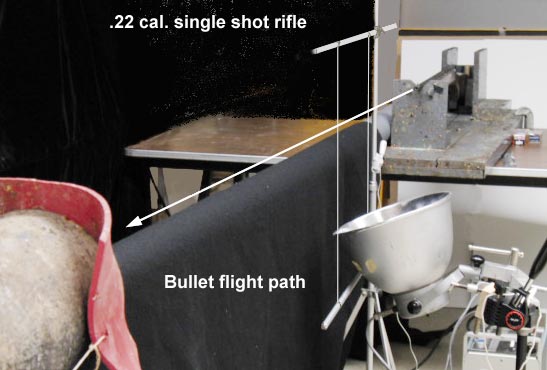 Eventually, with the lab in darkness, the camera is loaded with film and closed-up. Low level lighting can be turned on at that time and the camera is brought up to speed. Once the film is running at the desired rate (1000 inches per second in this case) the gun is fired. The bullet travels to its destination in the bullet catcher and in the process is lit up as it passes between the two marker wires by the electronic flash. The drum continues to turn at the desired rate and for this experiment a second round was also fired. A different bullet was used. Slower or faster than the previous one. It may overlap the trace left by the first one but more likely it will fall somewhere else on the 12 inches of film available per turn of the drum. Once the second round is fired the camera is powered down and once in the dark again, the film is removed and taken for processing. After processing the results are examined and they lead to the following analysis. After exposure and processing one has a negative that is somewhat longer than the amount of film that corresponds to one revolution or to the circumference of the drum because there is a certain length of overlap. In this case the strip of film was about 17 inches long. When the area that actually was available for recording was identified by inspection it was measured to be 11.88 inches. For the time being we will assume, as we have up until now, that it is 12 inches long. At 83.333 RPS the film is therefore moving at 1000 inches per second. In other words, every inch on the film stands for 1 millisecond or 1/1000 second.  Now we turn to the "streaks" the two flying bullets impressed onto the film as they traveled between the two vertical wires that were placed 1 foot apart. We note that one bullet, the one on the left for example, arrived at the wire closest to the stand that supported the rods from which the wires were hanging at some time. This is indicated by its trace traversing wire #1 shown at the bottom. Now in the time it took that bullet to reach the other wire, wire #2, a certain length of film was able to move through the camera so that the intersection is now located 1.06 inches to the right of the first one. This means that 1.06 milliseconds elapsed as it moved between wires. 1.06 milliseconds is the equivalent of 1/943.4 seconds. In other words the bullet moved 1 foot in 1/943.4 second or it was traveling at 943.4 feet per second. The bullet on the right, on the other hand, traversed the 1 foot distance in .80 milliseconds or in 1/1250 second and it was traveling at 1250 feet per second. Bullet 1 was subsonic while bullet two was supersonic.
In this record the onset of the electronic flash can also be seen as a region of gradually increasing exposure preceding the intersection of the bullet trace with the first wire. In addition, the smoke and hot ejected particles from the shot impress streaks on the moving film and these can be seen moving along with the bullets but at reduced velocity. This is indicated by the fact that the slope of their trajectory is less than that of the bullets. It is the slope of the streaks left by the bullets that ultimately indicates their velocity. Going to an "absurd" situation, if the slope is infinite (line crossing the film at right angles to the edge) then one of two situations exists. Either the film was not moving or the bullet was moving infinitely fast across the width of the film. If the slope is 0 then the bullet was not moving or the film was moving infinitely fast. You take your pick. At any in-between value the slope will be a clear indication of the relationship of motion between the film and the subject. This is indeed a case where a couple of streaks on the film are considered by me to be absolutely beautiful. If not from an aesthetic point of view certainly from a technical and data reduction point of view. Who would ever have thought that just four lines would be so informative about a couple of flying bullets!! Streak and strip cameras
are fantastic devices but often way under-exploited. If you want to talk
about these film based chronographs drop me a line at:
Andrew Davidhazy, andpph@rit.eduu |